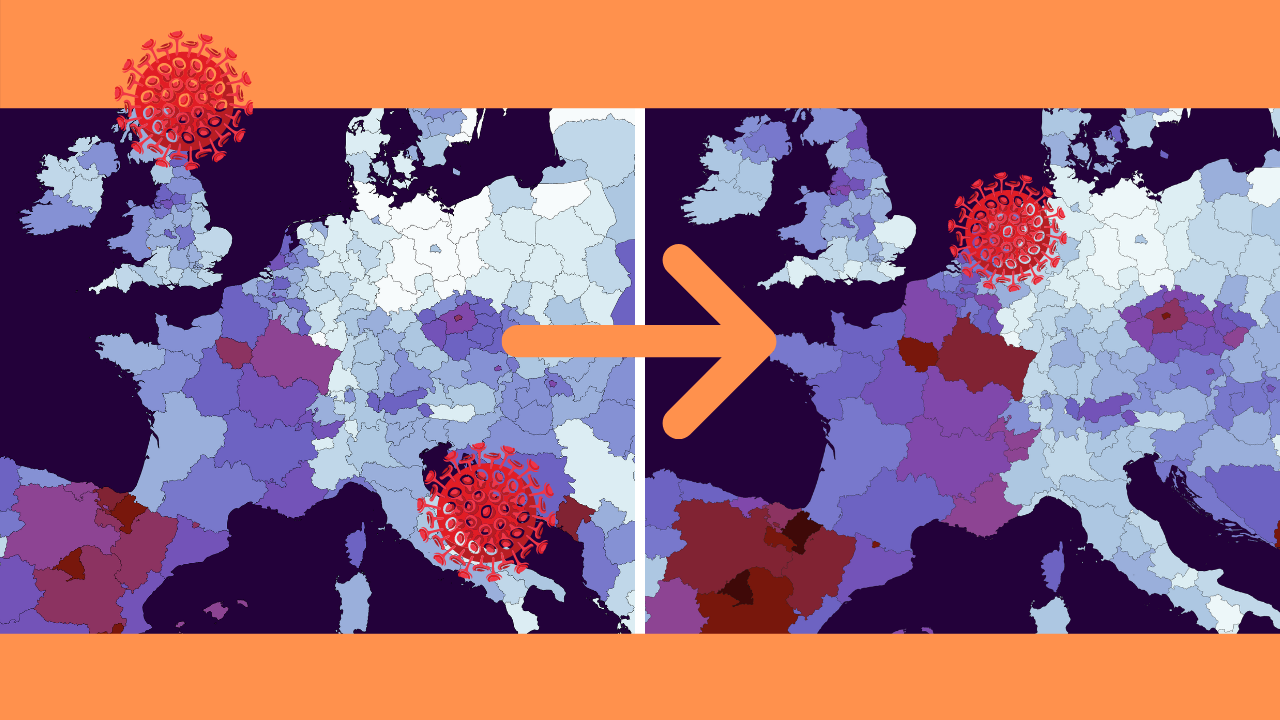
‘Autumn wave’ or ‘second wave’ – whatever you might call the spread right now. COVID-19 is barrelling across the continent at breakneck speed. The week from 12 to 19 September was dominated by record increases.
Governments are now attempting to curb the number of new patients with a set of new corona restrictions. Whether this will be enough, will not be apparent to us for another week or two. That is how long it will take before the effect of the measures becomes visible in the figures that show the spread.
The current wave is hitting Spain, France and the Czech Republic the hardest. Although the United Kingdom, the Netherlands, Belgium and Austria also registered higher numbers. This is how it is all shaping up on the latest weekly map:

New lockdown measures
The coming weeks are bound to be very exciting for all of Europe. Yes, the number of infections is rising to record levels. Yet there is also far more testing, so the increase in the number of new patients was also to be expected. After all, if you do a lot of testing, a lot of new patients will show up too.
They’re playing it safe in Great Britain. Because cities like Birmingham, Manchester and Newcastle exceeded the alarm value of 50 infections per 100,000 people in just one week, new lockdown measures came into force there again. A curfew and a six-person ‘bubble’ should stop the pandemic from spreading in those areas. It appears that London is also heading in this direction.
The situation is already critical in Spain and the Czech Republic. Hospitals in Madrid are filling up to the max. While in the Czech Republic, the Minister of Public Health stepped down after the country had a very calm spring and is now facing a pandemic onslaught. What does this all mean? A quick course in data interpretation was central in last week’s column.
The number of positive tests relative to the overall total played a prominent role back then. Because the coronavirus has so many patients with mild symptoms, the risk that the virus will continue to spread below the radar is very real. This is why the ECDC has set a threshold of 3 percent. If the number of positive tests exceeds this percentage, this could be an indication of an inadequate testing policy. With the ensuing result that the virus might spread in the same way as it did earlier this year.
In the map below, it is also immediately noticeable that more and more countries are above this threshold. In the meantime, the Netherlands has also passed that boundary.
Stringency index
Just like at the beginning of this year, governments are endeavoring through all kinds of measures to bring the curve down so that the tidal wave of new patients (and subsequently hospitalizations and deaths) remains under control. Nevertheless, some areas hardly any measures are needed at the moment.
For example, this is the case in Finland and Estonia, because the number of infections there is much lower than in Western Europe. The population there has to comply with far fewer corona regulations than elsewhere. Still, in order to keep it that way, their external borders are strictly secured. Non-essential travel from almost the whole of Western, Southern and Central Europe is banned for the time being.
But how exactly do you measure the level of ‘strictness’ of the corona regulations? These differ from country to country. Yet Our World in Data has come up with something for this. They devised the so-called Stringency Index which provides insight into the strictness levels of various corona regulations. During the third week of September in Europe, this is what that looks like:
Is Sweden really that lenient?
A common misconception surrounding corona regulations is that Sweden has the most lenient in Europe. It is quite true that this was indeed the case back in April, but nowadays the Scandinavian country is no longer one of the most ‘free’ countries. The Stringency Index is made up of a number of sub-scores, such as the maximum group size, travel restrictions, constraints on the opening of schools, stores and restaurants or whether or not a curfew is in force.
With a score of 63, Ireland is currently applying the strictest regulations. Spain and the United Kingdom are close behind. Sweden currently scores 37 points on this scale. That’s more than Estonia, Lithuania, Norway, Finland, Slovakia and Austria. Something that makes Sweden stricter than the rest, for example, is their ban on meetings with more than 50 attendees which has been in force since March.
At present in the Netherlands a maximum of one hundred attendees in a group is permitted. Since Sunday, this was lowered to 50 solely for the six worst-affected risk regions, the same amount as in Sweden. Where does this misconception stem from then? It is connected to the first wave. Indeed, the country never underwent a very severe lockdown in March, but it eased relatively little of it’s subsequent measures.
This is what this strictness score looked like in spring:
Harsh lockdown or ‘intelligent lockdown’
The word ‘lockdown’ sounds pretty concrete, but it’s actually not that at all. It remains a vague term, given that there is no unequivocal definition of it. But the stringency scores of April provide further insight into how many restrictions the government has imposed on the population.
Serbia went the furthest, with a score of 100. The country let itself be guided by China with its ‘Wuhan-lockdown’, worthy of the highest possible score whereby almost any movement outside the home is forbidden. A street ban for everyone after the stroke of 5 pm, military in the streets and the compulsory closure of all public buildings including retail stores. Extremely drastic measures were also in force in Spain, Italy and France where even fines could be dealt out if you ventured out onto the streets without a valid reason.
The Netherlands was in the middle bracket with 78 points. Although plenty was shut down, stores and businesses remained open and you weren’t liable to get fined for taking a ‘forbidden walk’. At that time the whole continent was looking at Sweden with raised eyebrows. It also scored ‘just’ 44 points on the restrictions index during the spring wave.
Not too strict, not too mild, not too long
Do those harsh lockdowns work better than the milder ones? This is quite difficult to determine considering the differences between countries. Nonetheless, it is not the case that those countries with the strictest lockdowns also suffered the fewest fatalities. On the contrary. Spain, Belgium and Italy actually had the highest mortality rates, despite their severe restrictions. But this is a bit of a chicken or egg situation. One thing is certain: Economic hardship was also the worst there.
The image of a ‘free’ Sweden was actually only ever valid between mid-March and mid-April. If you click on the play button, you can see that Norway and Finland soon ended their restrictions when the number of infections fell. Only 267 Norwegians and 337 Finns died during the pandemic, altogether around ten times less than in Sweden where almost 6,000 people lost their lives.
New measures are likely to be implemented within the next few weeks. What is strict enough? That differs depending on the country, society and situation. But it seems that too strict a lockdown leads to massive economic woes, but too ‘soft’ a lockdown costs a lot of lives. But this is least likely to ruin the economy, right? Not at all. The Swedish economy contracted by 8.4 percent in the second quarter. Although this was better than the European averages, the Finns and the Baltic States managed to keep the damage to a relative minimum while at the same time not losing thousands of lives.
Incidentally, short-term lockdowns cause less economic damage than longer variants, which comes as no surprise. What’s more, the population manages to cope with these shorter lockdowns more willingly. After all, eight weeks of house arrest rarely makes anyone happy. Yet all in all, if you ease up on measures too quickly, it invariably leads to chaos.








